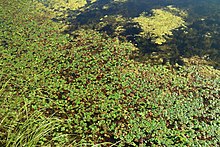Neuteich (Wundschuh)
| Neuteich | ||
|---|---|---|

|
||
| View from the southeast bank | ||
| Geographical location | Kaiserwald , Styria | |
| Tributaries | Poniglbach | |
| Drain | Poniglbach → Mühlgang → Mur | |
| Location close to the shore | Wound shoe | |
| Data | ||
| Coordinates | 46 ° 55 '38.5 " N , 15 ° 25' 42.2" E | |
|
|
||
| Altitude above sea level | 328 m above sea level A. | |
| surface | 2 ha | |
| length | 200 m | |
| width | 110 m | |
| scope | 580 m | |
|
particularities |
||
The Neuteich (formerly Neuer Teich ) is an artificial standing water in the Kaiserwald in the Austrian state of Styria . It is part of the Wundschuher Teiche and has been a Natura 2000 protected area since 2017 .
Location and surroundings
The Neuteich is - counted downstream - the second of the four large Wundschuher ponds on the Poniglbach and is located around 1.5 km west-northwest of Wundschuh . In the middle of the forest at 328 m above sea level. A. The water area between Forster pond and Wundschuher pond can be reached via a forest or hiking trail that leads past the east bank. From the large car park on Wundschuh-Straße ( L380 ) and from the village of Forst, you can walk to the bank of the pond in fifteen minutes.
Flora and fauna
The embankment on the Neuteich is formed by the slit-leaved coneflower , giant goldenrod , fine ray , glandular balsam and three-part two-toothed . The reed bed is made up of broad-leaved cattails and simple hedgehog . In floating leaf belt dominated by white water lily , Nymphoides peltata and floating pondweed . Submerged star liver moss , many-rooted pond lentils and common water hose are the most common floating plants . On the south and the entire east bank there is four-leaf clover, covering 1 to 2 m in the direction of the open water and up to about 70 cm deep . The plant is threatened with extinction in Central Europe and is protected accordingly (see nature conservation ).
In 2009 the occurrence of the Balkan moor frog on the Neuteich was investigated. The spawning process is therefore limited to a small large sedge population on the northwest bank. The other bank areas are steeper and each contain only a narrow vegetation line. Common frogs and common toads dominate there . The shallow water areas necessary for the moor frog's survival are only under water when the pond is fully covered. The success of reproduction therefore depends heavily on the water regime.
natural reserve
As a result of EU infringement proceedings against the Republic of Austria, a search began in 2014 for potential areas to implement Directive 92/43 / EEC (Fauna-Flora-Habitat Directive) . The nature conservation department of the state of Styria developed protected area proposals on the basis of the clover fern sites of the past 25 years and came across the Wundschuher ponds. Because the (four-leaved) clover only occurs there at Neuteich, the European protected area No. 45 “Wundschuh-Neuteich” was decreed on May 4, 2017.
While there is numerous evidence of the clover fern occurrence from the 1920s, the species disappeared in the 1950s due to the suspension of pond management. From 1994 the rare plant could be found again regularly. A stable population developed between 2006 and 2016, aided by the autumn leaving the pond and removing the reed beds on the east bank, which can also form sporocarpia when the water level is low . The conservation area ordinance provides for the regular removal of the reed portions, provision of pioneer sites by partial excavation and regular draining of the pond as conservation measures. The habitat types “mud flats” and “natural still waters with floating bodies” are also protected.
Web links
Individual evidence
- ↑ a b c Martin Magnes: The clover fern Marsilea quadrifolia in Styria. In: Communications from the Natural Science Association for Styria, Volume 45, Graz 2016, pp. 59–67. Online PDF , accessed November 8, 2019.
- ↑ Werner Kammel: Supplementary survey of the Balkan moor frog, Rana arvalis wolterstorffi (FEJÉRVÁRY, 1919) in Styria. Styrian Provincial Government - FA 13c (Nature Conservation), Wildon 2010, p. 6. Online PDF , accessed on November 1, 2019.
- ↑ a b Complete legal regulation for European protected area No. 45 - Wundschuh-Neuteich (AT2247000). Federal Chancellery , accessed on September 9, 2019 .

